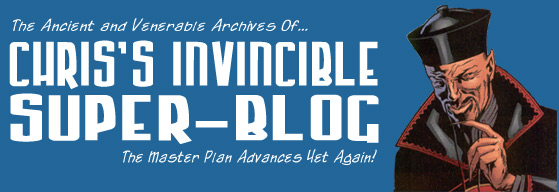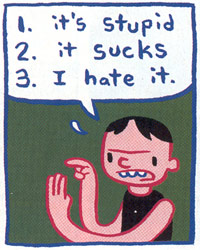Cowboy Joe's Two-Gun Manga Round-Up, Volume 4
Saddle up, ya rannies!

Yes, it's time for the fourth in my inexplicably cowboy-themed series of manga reviews, but this time, I've got a little something extra to throw on the stack.
 This week saw the release of Mangaka America, the new book from Tania Del Rio's SteelRiver Studio and publisher HarperCollins, whose friendly staff were nice enough to send one my way for review.
This week saw the release of Mangaka America, the new book from Tania Del Rio's SteelRiver Studio and publisher HarperCollins, whose friendly staff were nice enough to send one my way for review. As you might expect from the title, it's a book about American comics creators who work in manga style, and I'll be honest with you: It's not the book I expected. The talent roster they've got for this thing is impressive to say the least, including Del Rio (whose work I enjoy pretty much every time I run across it), Sharknife's Corey Lewis, and an introduction written by one of the most entertaining creators working in comics today, Adam Warren. A book the size of Mangaka America--which weighs in at a hefty 148 pages and stands slightly taller than your average single--that featured new sequential work from a lineup like the one they've got here would be a no-brainer purchase.
But like I said, that's not what we've got here. Instead, Mangaka America is an odd little mix of art book, interviews, and tutorials that, even with everything it's got going for it, suffers in a lot of places for never having enough of either one.
Don't get me wrong, there's a lot to like about it. Adam Warren's introduction alone is worth a read, written with a quick, charming style that should come as no surprise to anyone who's read his comics, and the reprinting of Tania Del Rio's bit on the terminology surrounding Original English Language manga from Popucultureshock is a fun addition that does a lot to set the tone for the rest of the book. The art's also done up very well, including beautiful pieces from folks I've never heard of before, and it certainly succeeded in making me want to check out what they've done.
For me, though, the problem really comes down to the tutorials. It's not really unexpected that they're in there; there's an entire niche market that's grown up around "How To" books for manga, and the fact that the entire style's predicated on adapting Japanese visual techniques and page construction means that it lends itself to technical discussion pretty easily, but I'm the sort of manga reader that really couldn't care less about how it's done, as opposed to the final result itself. There's not a whole lot that I can get out of Corey Lewis explaining how he creates his energetic pages that I couldn't get just from reading the pages themselves.
It's a frustrating thing to read for someone who doesn't have the talent or inclination (mostly the talent, to be honest) to do the artwork himself to read a book where someone who does have the talent tries to explain it. I've had a lot of conversations with my friends at work where we talk about those old How To Draw Comics The Marvel Way and Wizard Basic Training style books where somebody'll draw a circle, put some lines in it, and then magicallly end up with a fully-realized picture of Wolverine in the third image, and there's some of that mixed in here too. I swear, the tutorial section on Mech Design with Jesse Philips (which does feature some incredible pieces like a giant Pancho Villa robot that is flat-out awesome) can pretty much be boiled down to: "First, I design a mech. And then..."
The best of the tutorials, though, comes from Felipe Smith and does an absolutely fantastic job with teaching expressive faces that solves the problems inherent in the format by actually producing a fifteen-panel story that takes him through his frustrations with explaining how to draw, followed by a panel-by-panel explanation of what he did and why in each panel. It's innovative, and very similar to what Stan Sakai did to show how he creates Usagi Yojimbo by actually drawing a strip about Stan Sakai creating an issue of Usagi Yojimbo.
Admittedly, that's not a technique that'd work for everything they wanted to talk about in Mangaka America, like a step-by-step guide to digial inking or coloring, but Felipe certainly comes off affable and informative, as well as showing off his art a little bit more than the others get to do.
The interviews, too, leave me wanting a little more. To be fair, they were exactly what I expected: formulaic Q&A sessions with minor variations that keep to the standard "what are your influences" (a pretty broad question that could've used a few follow-ups to really get the specifics and draw the comparisons) and "Describe your work process" type questions that you always see. To their credit, they're both entertaining and informative in places--especially once you start noticing that pretty much every OEL manga creator loves to drink tea--but there's so much more to be said for an actual interview that touches on each creator's personal style.
The art, of course, is top notch, and every one of the creators profiled comes off very well-represented by the pieces that it features, but I still can't shake the feeling that it could've been pulled off a lot better if the focus was narrowed to showcase the manga itself and the people behind it rather than the processes they used.
But like I said, it's entirely possible that I'm judging it a bit too harsly, since I don't really have much of a desire to learn how to create manga. If, however, you do, you could do a lot worse than to pick it up and give it a read. The art's beautiful and pretty much everyone profiled comes off as extremely likeable, and even I, a guy who has to rip off someone else's style to draw stick figures, can recognize that there are some solid tips in there.
It's available now for $24.95 at your local shop, or about eight bucks cheaper on Amazon
I've mentioned Rivkah and Svetlana Chmakova--both of whom appear in Mangaka America--before on the ISB when I gave a pretty positive review to last year's releases of Steady Beat and DramaCon, which saw their sequels released last month. So how'd they stack up? Find out as the thunder rolls 'cross the plains in...
 Dramacon v.2
Dramacon v.2By Svetlana Chmakova
$9.99 at your local shop or on Amazon
Last time, I mentioned that what made DramaCon such an entertaining read was that Chmakova rounded up every single anime and manga cliche and put them all in one book, and with the second volume, she's keeping that up pretty well. It's hard to imagine that technique actually paying off, but Chmakova somehow ends up making it work incredibly well in both volumes.
Instead of coming off as hackneyed plot twists, the litany of cliches--which in v.2 include a new obstacle for Christie in the form of Matt's new girlfriend and a scene where (I swear to God) Christie actually runs through a rainstorm after Matt breaks her heart--are played as fun, self-aware homage and, at times, a self-parody of romance manga that does absolutely nothing to mitigate the quality of the story itself, especially when set against the truly bizarre and insular world of the anime convention.
It's every bit as good as the first volume, which I thoroughly enjoyed, and the new additions to the cast are as enjoyable to read about as the returning ones. Matt's new girlfriend, Emily, is treated much better than a cipher that stands in Christie's way on her quest for love, and Bethany, Christie's painfully shy new partner, stars in what may be the best scene in the whole book when she goes up against a kid who doesn't think she's doing "real manga."
One thing that did bother me, though, is that Chmakova constantly uses odd names for real people and products that seem reasonably out of place. It's odd enough when Christie's running around eating "Pawky," but why bother disguising Osamu Tezuka's name? Is somebody really going to sue? Because if so, I've got a lot to worry about when I finally finish my "Osamu Tezuka's Buddha vs. Al Hartley's Jesus" post.
 Steady Beat v.2
Steady Beat v.2By Rivkah
$9.99 at your local shop or on Amazon
On the other end of the romance spectrum, we've got Rivkah and Steady Beat, which, while it's got a lot of funny moments, strikes me as a much more traditional romance than DramaCon, except that it's set in Texas, revolves around a girl finding out that her sister's a lesbian, and features at least one bikini-clad chase scene.
Rats. Couldn't even make it through the first paragraph. Oh well.
Anyway, I think Steady Beat's awesome, but while the second volume has a lot more going for it than the first in terms of plot development and forward momentum, it seems to come at the expense of the visual tricks that characterized the last book, which I thoroughly enjoyed. There's a great one in this one that involves our heroine Leah--who investigates her sister's secret romance with another girl while dodging her state senator mother (clapclapclapclap!) deep in the heart of Texas and ends up being hit by a car and falling for Elijah, whose family boasts two fathers--and a disappearing/reappearing cat named Schrödinger, but it only lasts for a few pages.
Even without the fun visual tricks, though, Rivkah's art and page layouts are absolutely gorgeous, and while the second half of the book is extremely heavy on the romance--which isn't exactly a detriment when you're reading, y'know, a romance comic--there's enough going on throughout the book, which includes that favorite device, the Last Page Plot Twist, to keep it from reading like your standard meet-cute.
And that's pretty much that for another rip-snortin' installment of manga-citement. Now git along, little doggies, afore I'm forced ta continue typing in faux Jonah Hex dialogue!
YEE-HAW!



5 Comments:
But...but I LOVE Jonah Hex dialogue!
11/02/2006 10:19 AM
You really should have done the entire post in Jonah Hexalogue.
"Readin' these here Japanese funny-books makes me a put-near total filly. Dang, that ain't gonna be no pull-quote, will it?"
11/02/2006 2:27 PM
writing like Jonah is a lot harder than it looks
11/02/2006 10:05 PM
Where the heck is the Week in Ink???
11/03/2006 8:22 AM
I've always wondered what it would be like to be a shepherd...
11/03/2006 3:53 PM
Post a Comment
<< Home